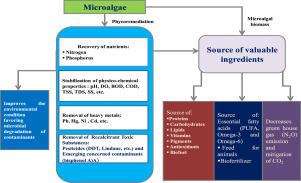Environmental Technology & Innovation ( IF 6.7 ) Pub Date : 2020-12-25 , DOI: 10.1016/j.eti.2020.101340 Dig Vijay Singh , Rouf Ahmad Bhat , Atul Kumar Upadhyay , Ranjan Singh , DP Singh

|
Water pollution has grown to be a grave concern in the world. Direct discharge of wastewater poses risks to the aquatic ecosystems by causing eutrophication and degrades their physico-chemical characteristics. Moreover, wastewater is mainly enriched with recalcitrant toxic substances that pose detrimental impacts on the receiving environments. Conventional treatment approaches are mostly applied to remove nuisance pollutants from aquatic systems but are expensive and inefficient. Exploring microalgae has been found to be an efficient and ecofriendly technique for purification of aquatic environs. Furthermore, microalgae can effectively remove N (90–98.4%), P (66%–98%), Pb (75%–100%), Zn (15.6–99.7%), Cr (52.54%–96%), Hg (77%–97%), Cu (45%–98%) and Cd (2–93.06%)from contaminated aquatic systems. Microalgae play a pivotal role in degrading the complex pesticides (-endosulfan, lindane, isoproturon and glyphosate) and emerging concerned contaminants (triclosan, bisphenol A, 17-ethinylestradiol, tramadol and diclofenac) in elegant manner from disturbed environs. Apart from toxic pollutant removal, microalgae produce biomass, thereby acts as the efficient source of additional products like biofuel, carbohydrates, lipids and proteins which can make phycoremediation more frugal and sustainable.
中文翻译:

水生环境中的微藻:修复重金属和新出现污染物的可持续方法
水污染已成为世界范围内的严重问题。废水的直接排放会引起富营养化并降低其理化特性,从而给水生生态系统带来风险。此外,废水中主要富含顽固的有毒物质,会对接收环境造成不利影响。常规处理方法主要用于去除水生系统中的有害污染物,但价格昂贵且效率低下。发现微藻是一种用于净化水生环境的有效且环保的技术。此外,微藻可有效去除N(90–98.4%),P(66%–98%),Pb(75%–100%),Zn(15.6–99.7%),Cr(52.54%–96%),Hg (77%–97%),Cu(45%–98%)和Cd(2–93.06%)来自受污染的水生系统。-硫丹,林丹,异丙隆和草甘膦)和新出现的相关污染物(三氯生,双酚A,17-乙炔雌二醇,曲马多和双氯芬酸)以优雅的方式来自周围的环境。除了去除有毒污染物外,微藻还产生生物质,因此可以作为其他产品(例如生物燃料,碳水化合物,脂质和蛋白质)的有效来源,这些物质可以使phycoremediation更加节俭和可持续。











































 京公网安备 11010802027423号
京公网安备 11010802027423号